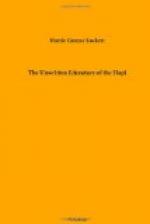The Snake Dance, so-called, is the culmination of an eight-days’ ceremonial, an elaborate prayer for rain and for crops. Possibly something of the significance of parts of its complicated ritual may have been forgotten, for some of our thirst for knowledge on these points goes unquenched, in spite of the courteous explanations the Hopi give when our queries are sufficiently courteous and respectful to deserve answers. And possibly some of the things we ask about are “not for the public” and may refer to the secret rituals that take place in the kivas, as in connection with many of their major ceremonials.
We do know that the dramatization of their Snake Myth constitutes part of the program. This myth has many variations. The writer, personally, treasures the long story told her by Dr. Fewkes, years ago, and published in the Journal of American Ethnology and Archaeology, Vol. IV., 1894, pages 106-110. But here shall be given the much shorter and very adequate account of Dr. Colton,[28] as abbreviated from that of A.M. Stephen:
“To-ko-na-bi was a place of little rain, and the corn was weak. Tiyo, a youth of inquiring mind, set out to find where the rain water went to. This search led him into the Grand Canyon. Constructing a box out of a hollow cottonwood log, he gave himself to the waters of the Great Colorado. After a voyage of some days, the box stopped on the muddy shore of a great sea. Here he found the friendly Spider Woman who, perched behind his ear, directed him on his search. After a series of adventures, among which he joined the sun in his course across the sky, he was introduced into the kiva of the Snake people, men dressed in the skins of snakes. The Snake Chief said to Tiyo, ’Here we have an abundance of rain and corn; in your land there is but little; fasten these prayers in your breast; and these are the songs that you will sing and these are the prayer-sticks that you will make; and when you display the white and black on your body the rain will come.’ He gave Tiyo part of everything in the kiva as well as two maidens clothed in fleecy clouds, one for his wife, and one as a wife for his brother. With this paraphernalia and the maidens, Tiyo ascended from the kiva. Parting from the Spider Woman, he gained the heights of To-ko-na-bi. He now instructed his people in the details of the Snake ceremony so that henceforth his people would be blessed with rain. The Snake Maidens, however, gave birth to Snakes which bit the children of To-ko-na-bi, who swelled up and died. Because of this, Tiyo and his family were forced to emigrate and on their travels taught the Snake rites to other clans.”
[Footnote 28: Colton, H.S., Op. cit., p. 18.]
Most of the accounts tell us that later only human children were born to the pair, and these became the ancestors of the Snake Clan who, in their migrations, finally reached Walpi, where we now find them, the most spectacular rain-makers in the world.




